
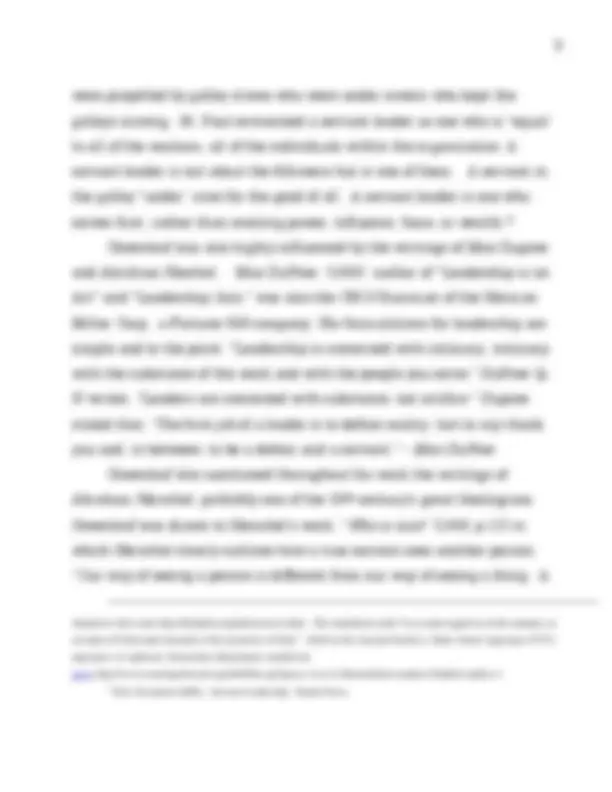
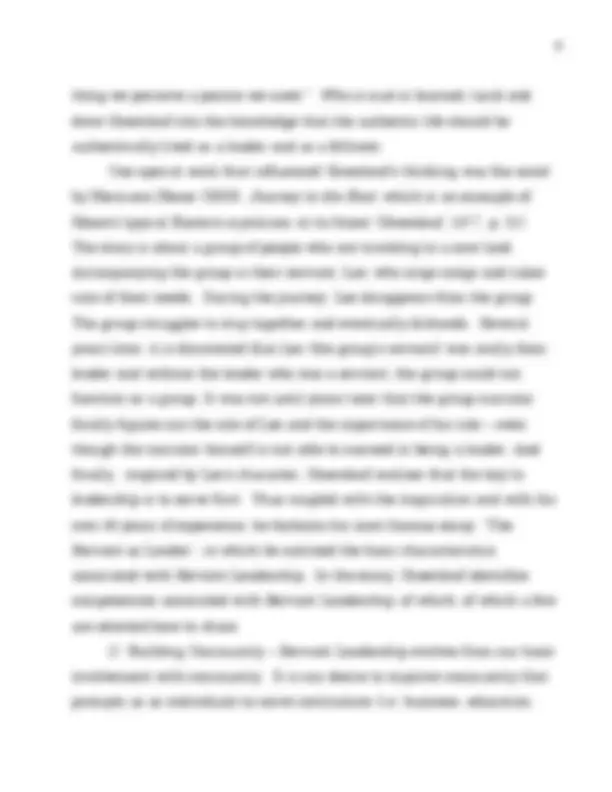
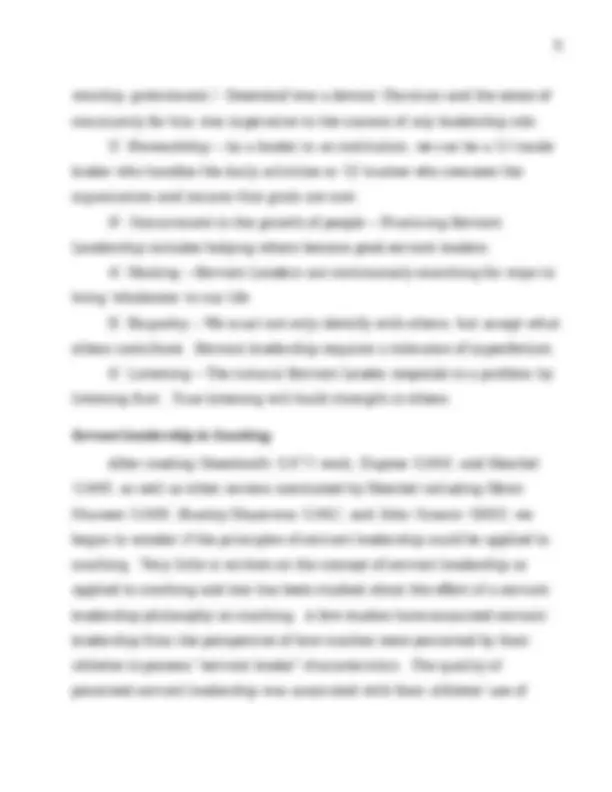
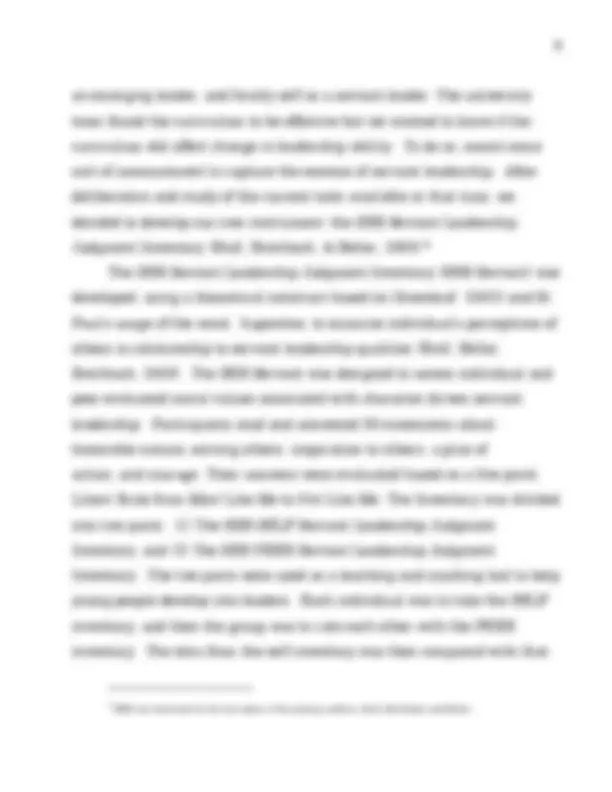
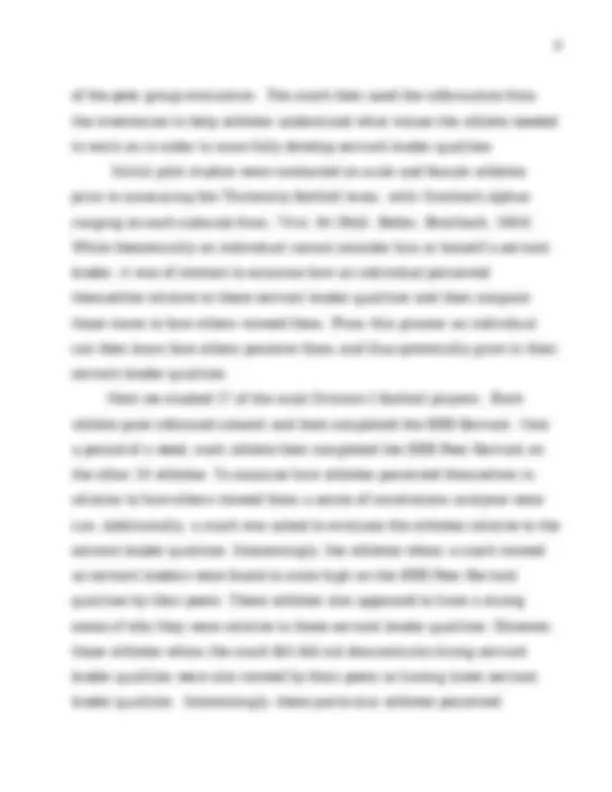
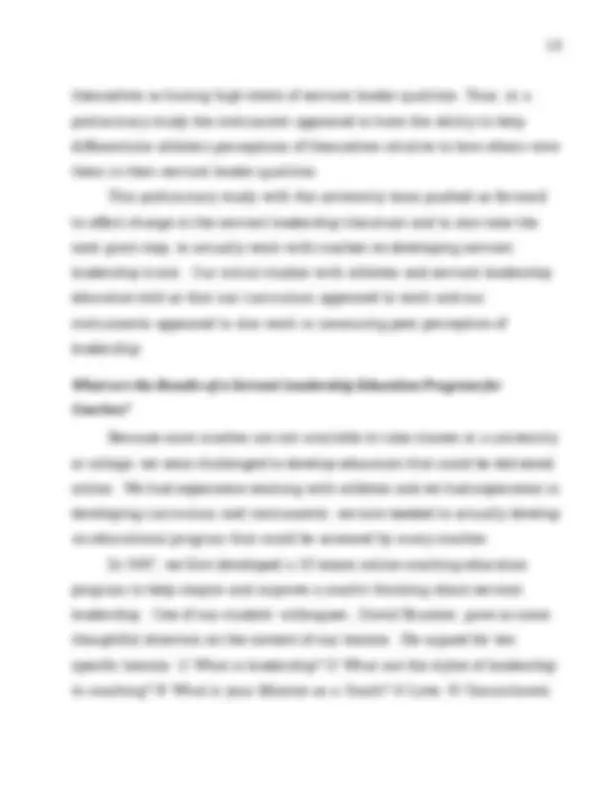
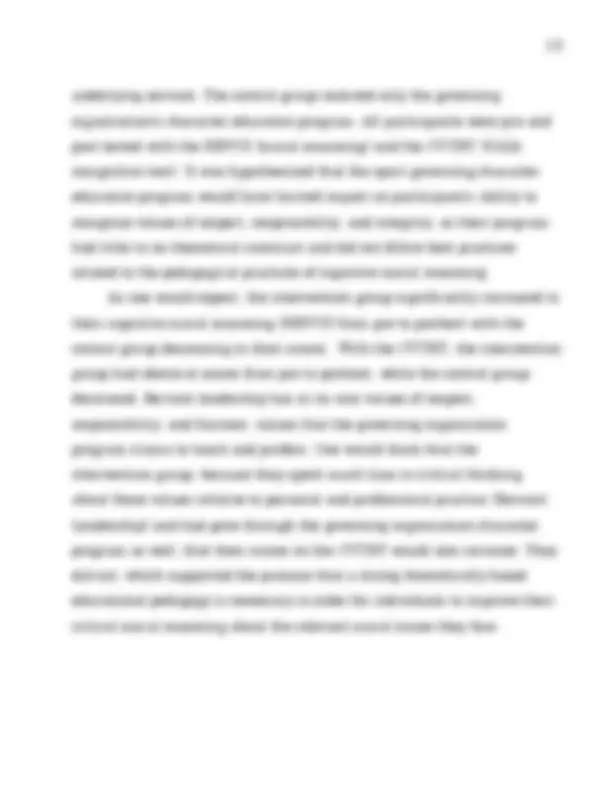
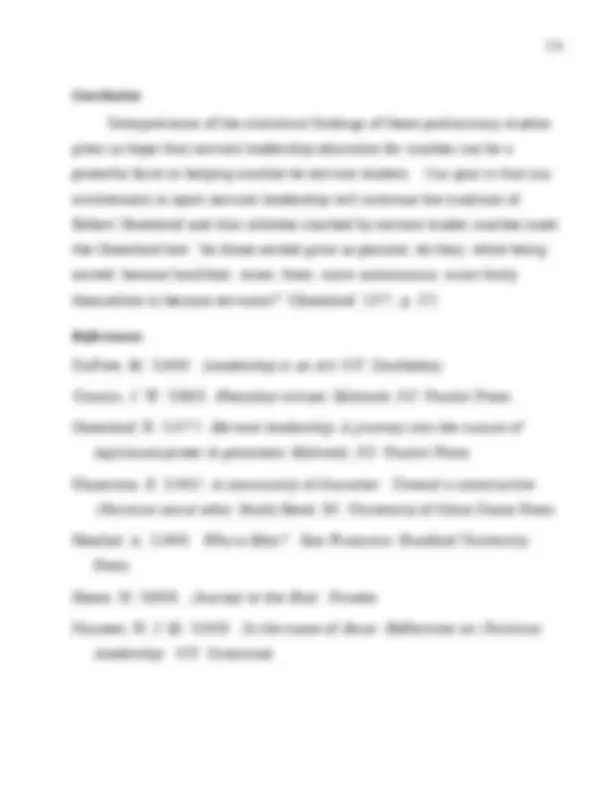
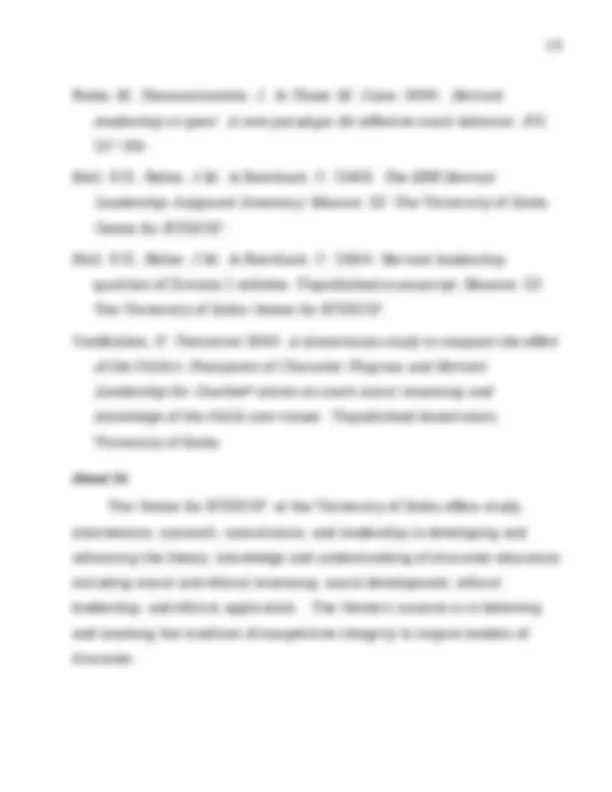


Study with the several resources on Docsity

Earn points by helping other students or get them with a premium plan


Prepare for your exams
Study with the several resources on Docsity

Earn points to download
Earn points by helping other students or get them with a premium plan
Community
Ask the community for help and clear up your study doubts
Discover the best universities in your country according to Docsity users
Free resources
Download our free guides on studying techniques, anxiety management strategies, and thesis advice from Docsity tutors
The application of Robert Greenleaf's servant leadership philosophy to coaching. Greenleaf, influenced by writers like Max DePree and Abraham Heschel, emphasized serving others as the priority in leadership. how servant leadership can be applied to coaching, its potential impact on athletes, and the development of a servant leadership curriculum for university coaches.
Typology: Assignments
1 / 15

This page cannot be seen from the preview
Don't miss anything!










Stoll, S. K., Beller, J. M., VanMullem, P., Brunner, D., & Barnes, J. (2009). Servant leadership in coaching. Published proceedings: International Conference in honor of the 75-year Anniversary of the Sports Games Department of the Lesgaft State University of Physical Culture, St. Petersburg, Russia, pp. 169-175.
What is Servant Leadership?
Greenleaf spent the majority of his organizational life in the field of management, research, development, and education at American Telephone and Telegraph (AT&T). His job at AT&T was to study how the best leaders emerged in an organization and in that role he studied the best and most successful organizations. After a half century of working with large organizations and teaching at a variety of colleges and universities about business management, Greenleaf distilled his observations in a series of essays and books on the theme of "The servant as leader" and then established a Center dedicated to servant leadership.^1 At the time, his essays and books were uniquely different from the majority of organizational texts for none spoke of leadership as serving. Rather, organization texts spoke of effective management. No texts ever focused on leadership as service.
(^1) The Greenleaf Center for Servant Leadership is located in Westfield, Indiana, and can be found at: http://www.greenleaf.org/
In all of these works, Greenleaf described the need for a new kind of leadership model - a model which puts serving others as the number one priority. Servant-leadership emphasizes increased service to others; a holistic approach to work; promotes a sense of community and the sharing of power in decision making. Who is a servant-leader? Greenleaf said that the servant-leader is one
natural feeling that one wants to serve, to serve first. Then conscious choice brings one to aspire to lead. The best test is: do those served grow as persons; do they, while being served, become healthier, wiser, freer, more autonomous, more likely themselves to become servants? And, what is the effect on the least privileged in society; will they benefit, or at least, not be further deprived?" (Greenleaf, 1977, p. 352). Greenleaf was very clear in his discussion of a servant leader and how he developed the concept of servant leadership. Greenleaf, a prolific reader of leadership and of literature in general, borrowed from the work of numerous writers who also had a visionary perspective about the role of serving through leadership. First and probably most importantly, Greenleaf was inspired by the writings of St. Paul in the New Testament. St. Paul described a servant as "an under rowers or the actual Greek word of huperetes (Fourth Chapter of 1 Corinthians)^2 In St. Paul‟s period of Roman dominance, galley ships
(^2) The actual word used by St. Paul is huperetes , the under-rower. It derives its meaning from the military life of the Roman empire, notably the warships, the war galleys of the Romans, which as we're told in that ancient world had a low deck just a foot or so above the water, and there were the seats of the rowers, the slaves, who were for the most part
drew Greenleaf into the knowledge that the authentic life should be authentically lived as a leader and as a follower. One special work that influenced Greenleaf's thinking was the novel
Hesse's typical Eastern mysticism at its finest (Greenleaf, 1977, p. 21). The story is about a group of people who are traveling to a new land. Accompanying the group is their servant, Leo, who sings songs and takes care of their needs. During the journey, Leo disappears from the group. The group struggles to stay together and eventually disbands. Several years later, it is discovered that Leo (the group‟s servant) was really their leader and without the leader who was a servant, the group could not function as a group. It was not until years later that the group narrator finally figures out the role of Leo and the importance of his role – even though the narrator himself is not able to succeed in being a leader. And finally, inspired by Leo‟s character, Greenleaf realizes that the key to leadership is to serve first. Thus coupled with the inspiration and with his own 40 years of experience, he fashions his most famous essay, “The Servant as Leader”, in which he outlined the basic characteristics associated with Servant Leadership. In the essay, Greenleaf identifies competencies associated with Servant Leadership, of which, of which a few are selected here to share.
worship, government.) Greenleaf was a devout Christian and the sense of community for him was imperative to the success of any leadership role.
Servant Leadership in Coaching
After reading Greenleaf's (1977) work, Dupree (1989), and Heschel (1965), as well as other writers mentioned by Heschel including Henri Nouwen (1993), Stanley Hauerwas (1981), and John Crossin (2002), we began to wonder if the principles of servant leadership could be applied to coaching. Very little is written on the concept of servant leadership as applied to coaching and less has been studied about the effect of a servant leadership philosophy on coaching. A few studies have examined servant leadership from the perspective of how coaches were perceived by their athletes to possess "servant leader" characteristics. The quality of perceived servant leadership was associated with their athletes' use of
We believed that the coaching model should follow the same simple ideal but profound vision of Robert Greenleaf, who said that,: It begins with the natural feeling that one wants to serve, to serve first. Then conscious choice brings one to aspire to lead. The best test is: do those served grow as persons; do they, while being served, become healthier, wiser, freer, more autonomous, more likely themselves to become servants? And, what is the effect on the least privileged in society; will they benefit, or at least, not be further deprived? (Greenleaf, 1977, p. 27.). Servant-leadership encourages everyone to balance leading and serving within their own lives. For people who are in leadership positions, it reminds us that our primary responsibility is in serving others. For people who are in follower positions, it encourages us to look for situational opportunities to provide leadership. The end result of this moving back and forth between leading and following is to enhance our lives as individuals, and to raise the possibilities of our many institutions. Our first project in 2002 was to examine the possibilities of affecting change toward servant leadership by developing first a curriculum focused on the qualities of servant leadership. Second, we developed an assessment tool that measured qualities necessary to be a servant leader. At the time, we were working with a large United States University football team. The coach had asked us to write curriculum focused on servant leadership that their coaches could teach. When we did such, we wanted to assess the effectiveness of our curriculum. We developed a four year curriculum for the university team in which we worked to educate the players about the importance of character in relation to servant leadership. The curriculum begins with examination of self, self as a follower, self as
an emerging leader, and finally self as a servant leader. The university team found the curriculum to be effective but we wanted to know if the curriculum did affect change in leadership ability. To do so, meant some sort of measurement to capture the essence of servant leadership. After deliberation and study of the current tools available at that time, we decided to develop our own instrument: the SBB Servant Leadership Judgment Inventory (Stoll, Breitbach, & Beller, 2003).^5 The SBB Servant Leadership Judgment Inventory (SBB Servant) was developed, using a theoretical construct based on Greenleaf (2002) and St. Paul‟s usage of the word, huperetes, to examine individual‟s perceptions of others in relationship to servant leadership qualities (Stoll, Beller, Breitbach, 2003). The SBB Servant was designed to assess individual and peer evaluated moral values associated with character driven servant leadership. Participants read and answered 50 statements about: honorable nature, serving others, inspiration to others, a plan of action, and courage. Their answers were evaluated based on a five point Likert Scale from Most Like Me to Not Like Me. The Inventory was divided into two parts: (1) The SBB SELF Servant Leadership Judgment Inventory, and (2) The SBB PEER Servant Leadership Judgment Inventory. The two parts were used as a teaching and coaching tool to help young people develop into leaders. Each individual was to take the SELF inventory, and then the group was to rate each other with the PEER inventory. The data from the self inventory was then compared with that
(^5) SBB was shortened for the last names of the primary authors, Stoll, Breitbach, and Beller.
themselves as having high levels of servant leader qualities. Thus, in a preliminary study the instrument appeared to have the ability to help differentiate athlete‟s perceptions of themselves relative to how others view them in their servant leader qualities. This preliminary study with the university team pushed us forward to affect change in the servant leadership literature and to also take the next giant step, to actually work with coaches on developing servant leadership traits. Our initial studies with athletes and servant leadership education told us that our curriculum appeared to work and our instruments appeared to also work in measuring peer perception of leadership.
What are the Results of a Servant Leadership Education Program for Coaches?
Because most coaches are not available to take classes at a university or college, we were challenged to develop education that could be delivered online. We had experience working with athletes and we had experience in developing curriculum and instruments, we now needed to actually develop an educational program that could be accessed by many coaches. In 2007, we first developed a 10 lesson online coaching education program to help inspire and improve a coach's thinking about servant leadership. One of our student- colleagues,, David Brunner, gave us some thoughtful direction on the content of our lessons. He argued for ten specific lessons: 1) What is leadership? 2) What are the styles of leadership in coaching? 3) What is your Mission as a Coach? 4) Love, 5) Commitment,
reflective assessment of their reasoning about servant leadership and the values posted in the lesson. The multiple choice questions are unique, for if a participant chooses and an answer that is not correct or not the best choice, the reader is linked back to start again, read more information, do more reflection, before choosing an answer again. Thus, the multiple choice questions inspire and force reflection about their choices. The assessment tool asks a series of questions about the lesson and the coaches' responses including a reflective piece on each lesson. The 2007 preliminary study appeared successful and a good foundation to increase the size and scope of the project.. In 2008, we conducted an additional preliminary study of this program lead by Mr.VanMullem. What is so important about Mr.VanMullem's study using our Servant Leadership Online Education Program is that usually education and social science researchers are often limited to a sample of self-selected volunteers and/or intact groups. Thus, major limitations in research design exist and the ability to generalize those results to the greater population occurs.
underlying servant. The control group received only the governing organization's character education program. All participants were pre and post tested with the HBVCI (moral reasoning) and the CVTRT (NAIA recognition test). It was hypothesized that the sport governing character education program would have limited impact on participant‟s ability to recognize values of respect, responsibility, and integrity, as their program had little to no theoretical construct and did not follow best practices related to the pedagogical practices of cognitive moral reasoning. As one would expect, the intervention group significantly increased in their cognitive moral reasoning (HBVCI) from pre to posttest with the control group decreasing in their scores. With the CVTRT, the intervention group had identical scores from pre to posttest, while the control group decreased. Servant leadership has at its core values of respect, responsibility, and fairness, values that the governing organization program claims to teach and profess. One would think that the intervention group, because they spent much time in critical thinking about these values relative to personal and professional practice (Servant Leadership) and had gone through the governing organization character program as well, that their scores on the CVTRT would also increase. They did not, which supported the premise that a strong theoretically based educational pedagogy is necessary in order for individuals to improve their critical moral reasoning about the relevant moral issues they face.
Conclusion
Interpretation of the statistical findings of these preliminary studies gives us hope that servant leadership education for coaches can be a powerful force in helping coaches be servant leaders. Our goal is that our involvement in sport servant leadership will continue the tradition of Robert Greenleaf and that athletes coached by servant leader coaches meet the Greenleaf test: "do those served grow as persons; do they, while being served, become healthier, wiser, freer, more autonomous, more likely themselves to become servants?" (Greenleaf, 1977, p. 27).
References:
Press.